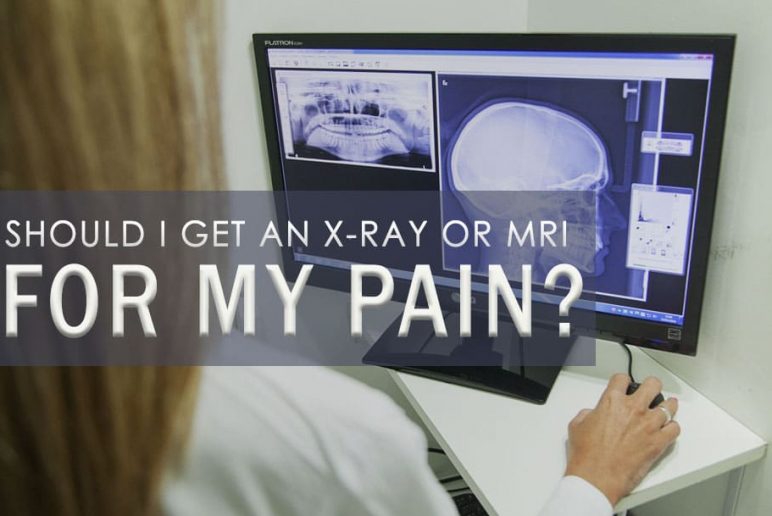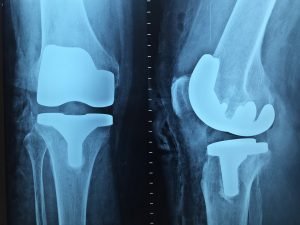
Should I Get an X-Ray or MRI for My Pain?
August 23, 2017After experiencing an injury, many people ask themselves the question, “Should I have an X-ray, MRI, or CT scan before I come to therapy?”
What should I do?
 Well, our intuition would typically say “I have back pain, therefore an x-ray or MRI will help me determine what’s wrong and how to go about fixing it.” We must know the medical diagnosis before we can go about treating a condition, right? Although this is a fairly common and reasonable view, imaging reports associated with physical pain, especially when the pain has lasted for a long time, provide limited information to determine appropriate treatment strategies and likelihood of recovery.
Well, our intuition would typically say “I have back pain, therefore an x-ray or MRI will help me determine what’s wrong and how to go about fixing it.” We must know the medical diagnosis before we can go about treating a condition, right? Although this is a fairly common and reasonable view, imaging reports associated with physical pain, especially when the pain has lasted for a long time, provide limited information to determine appropriate treatment strategies and likelihood of recovery.
There are important situations where your physician may order an x-ray, MRI, or CT scan prior to referring you to physical therapy. This may be to determine the nature of a recent injury or a serious medical condition if suspected. In other cases, you may come directly to physical therapy and the physical therapist will refer you to your physician for this same reason.
So if you begin physical therapy without having an x-ray, MRI, or CT scan first, this is often because your physician or other qualified health professional has determined that you are likely to recover without costing you the time and financial burden of an imaging study.
What do my results mean?
It is rare that an imaging report is completely normal or “unremarkable.” Most people have some degree of degeneration, disc protrusion, bone spurs, and other findings. It is important to understand that many individuals can be pain free yet display “abnormal findings” on an imaging report. There are many people who have varying ranges of pain and do not show associated findings on an x-ray or MRI report. So the presence of “arthritis” or “disc protrusions” and many other findings require further context to determine their significance.
As we have advanced in our understanding of treating pain and physical injury, we have learned that there are many factors that come into play when finding the “root cause.” These have more to do with health factors, mobility, and physical limitation than they do with pure findings on an imaging report. Some common ways to make a good recovery generally include:
- Getting a good amount of sleep
- A well-balanced diet
- Low stress levels
- Exercising regularly
Therefore, the meaning of your x-ray, MRI, CT scan or other imaging report requires interpretation by those qualified to do so in addition to other physical factors which help determine the best course of action.
Why do physical therapy when surgery can “fix the problem”?
 Although many people reap the benefits of surgical procedures, it can also be traumatizing for some, as they often come with inherent health risks. It costs precious time, finances, and often prolongs recovery. It is a decision one makes with careful consideration when other options are not available or have been exhausted.
Although many people reap the benefits of surgical procedures, it can also be traumatizing for some, as they often come with inherent health risks. It costs precious time, finances, and often prolongs recovery. It is a decision one makes with careful consideration when other options are not available or have been exhausted.
Physical therapists are the function and movement experts. This means that physical therapists are committed to helping you regain your mobility, strength, and improve your overall physical health to live your life to the fullest. Whether that be picking up your grandchildren or returning to a sport you love, a physical therapist’s primary goal is to help you achieve an optimal quality of life.
In the end, it is your health. Regain control of your pain and choose the option that supports your ability to recover and thrive!
REQUEST A FREE CONSULTATION
We will contact you to confirm your appointment.WANT MORE TIPS?
During her free time, Faith enjoys exercise and weight training, visiting friends/family, reading, hiking, and seeking unique and delicious restaurants.
Latest posts by Faith Crary, PT, DPT (see all)
- Beat the Heat: Fun Summer Activities for Hot Weather - June 21, 2018
- You Are What You Eat: Pain and Diet - May 30, 2018
- Dancers: Achieve Your Best Turnout! - October 12, 2017
- Healthy & Delicious Breakfast Recipes - September 13, 2017
- How to Get a Restful Night’s Sleep - August 30, 2017
- Should I Get an X-Ray or MRI for My Pain? - August 23, 2017
Reader Interactions
Leave a comment Cancel reply
You must be logged in to post a comment.
SIGN UP FOR
LIFE+ is a FREE membership
that offers:
• Informative Newsletters
• Health & Wellness Tips
• Videos from Our Experts
• Special offers
…and much more!
SEARCH

GET MORE TIPS! PAIN 101 TUTORIALS
EXPLORELATEST TWEETS
ARCHIVES
- February 2025
- August 2024
- February 2024
- November 2023
- September 2023
- July 2023
- June 2023
- January 2023
- November 2022
- October 2022
- September 2022
- August 2022
- July 2022
- June 2022
- May 2022
- April 2022
- March 2022
- December 2021
- November 2021
- October 2021
- September 2021
- August 2021
- July 2021
- June 2021
- April 2021
- March 2021
- February 2021
- January 2021
- December 2020
- November 2020
- October 2020
- September 2020
- August 2020
- April 2020
- March 2020
- February 2020
- January 2020
- December 2019
- November 2019
- October 2019
- September 2019
- August 2019
- July 2019
- June 2019
- May 2019
- April 2019
- March 2019
- February 2019
- January 2019
- November 2018
- September 2018
- August 2018
- July 2018
- June 2018
- May 2018
- April 2018
- March 2018
- February 2018
- January 2018
- December 2017
- November 2017
- October 2017
- September 2017
- August 2017
- July 2017
- June 2017
- May 2017
- April 2017
- March 2017
- February 2017
- January 2017
- December 2016
- November 2016
- October 2016
- September 2016
- August 2016
- July 2016
- June 2016
- May 2016
- April 2016
- March 2016
- February 2016
- January 2016
- December 2015
- November 2015
- October 2015
- September 2015
- August 2015
- July 2015
- June 2015
- May 2015
- April 2015
- March 2015
- February 2015
- January 2015
- December 2014
- November 2014
- October 2014
- September 2014





